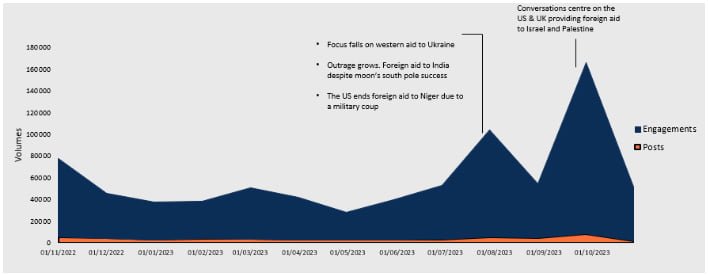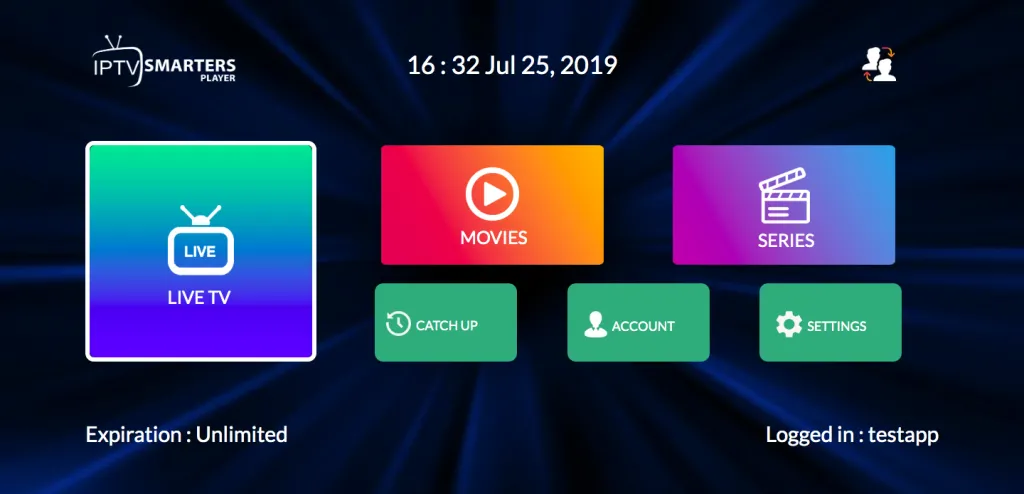
Leveraging stakeholder conversations for strategic planning
Having a full view of your wider stakeholder conversations across media, online, and social media gives you an advantage when shaping your comms strategy. Access to data across multiple channels can help you detect emerging trends and crises, and provide insights into public opinion, identify misinformation, and present opportunities to educate where needed.
For insight into the media and online landscape when it comes to conflict, we took the topic of foreign aid and tracked the conversation between 1 November 2022 – 31 October 2023 with our sister platform Pulsar.
Read on for how stakeholder insight can help you tailor your comms strategy.
Trends dominating the foreign aid discussion from November 2022 – October 2023

Volumes of the Foreign Aid conversation on X between 1 November 2022 and 31 October 2023. Source: Pulsar TRAC

Mentions of different themes in the Foreign Aid conversation between 1 November 2022 – 31 October 2023. Source: Pulsar TRAC
As global conflict unfolded throughout 1 November 2022 to 31 October 2023, related media coverage naturally grew to keep the public informed. But which topics took up the most attention when it came to foreign aid?
Tracking sharing of, and engagement with, posts on X during this period uncovered obvious subjects peaking the discussion. These included countries involved in geo-political crisis – ‘Ukraine’ and ‘Israel’ – as well as where displaced members of their population would go for safety (‘immigration’).
Alongside these aforementioned trends was a significant engagement with the topics of the domestic need for money and corruption – two issues that often go hand-in-hand with the costly realities of conflict and aid.
News sources dominating the conversation of foreign aid between Nov 22 – Oct 23

Volume of Outlet by Credibility on X in the Foreign Aid conversation between Nov 1 2022 – Oct 31 2023. Source: Pulsar TRAC
When looking at media outlets across the world, expected long-established news sources including The Guardian, the Express, and BBC News produced plenty of coverage and engagement during the year of analysis. Outlets considered non-credible by Pulsar’s misinformation detection – including the US-based right-wing brand Breitbart – also feature. But at the top is a relative newcomer to the press landscape – GB News.
Launched in 2021, GB News’ right-leaning political slant has attracted an audience with a matching right-wing mindset. UK politicians regularly feature in GB News programming (to some controversy), clips are shared across social platforms, and other news outlets regularly cover its fluctuating fortunes. Despite questions around impartiality and audience numbers, its influence online grows.
How do political leanings impact which topics attract the most engagement from stakeholders, and how can you attract attention with your own comms?
Which topics interest which stakeholders

Share of Narratives by Community in the Foreign Aid conversation between Nov 1 2022 – Oct 31 2023. Normalized to 100. Source: Pulsar TRAC
An analysis of stakeholders grouped by their political affiliations (as identified by their online affinities and behaviours) shows their differing preoccupations and interests, as well as different styles of interaction with messaging.
A comparison of UK-based Conservatives, UK Republicans, and Left-leaning audiences engaging in the online foreign aid conversation unearths high engagement for ‘immigration’ topics from right-wingers in the United Kingdom, with less engagement for ‘Israel’ and the ‘Domestic Need for Money’.
Left-wingers are equally engaged in the four of these trending topics tracked, while US right-wingers engaging in these topics were most invested in Ukraine and Corruption-focused reporting.
What does this show us? US and UK right-wing stakeholders engaged in singular discussions, with broader narratives taking the attention of global left-wingers.

Volume, visibility & impressions for communities on X between Nov 1 2022 – Oct 31 2023. Normalized to 100. Source: Pulsar TRAC
Analysing impressions (how many people see the content) versus visibility (a bespoke Pulsar metric that reflects how how much impact a piece of content has) also uncovers a clear difference – right-wing content between November 2022 and October 2023 gained viral traction in specific communities, where left-leaning content resonated more widely.
What does this mean when seeking meaningful engagement with all groups, regardless of political affiliation?
Engaging your stakeholders with your comms
Tailoring your strategy and communications for each audience online is how to hit each of your stakeholder segments. Considering where each of these gets their information and how they share it with their own communities provides a map for reaching them.
This could mean making Facebook groups or podcasts a part of your outreach strategy alongside the news channels your stakeholders watch daily with your messaging, or creating short-form content for specific social media platforms designed to be shared quickly and widely.
Engaging with global conversations of conflict is complicated, but an understanding of your stakeholders, where to find them, what they interact with, and how, provides a clearer direction for your comms strategy going forward.
For more on planning your strategy in times of crisis, find out about Vuelio’s horizon scanning solutions.





